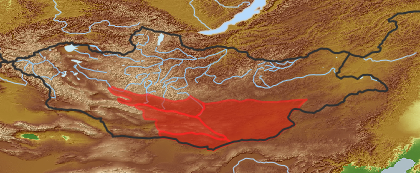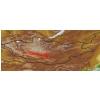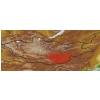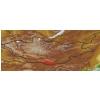| Class: | angiosperms |
| Order: | Rosales |
| Family: | Rosaceae |
| Genus: | Potaninia |
| Scientific name: | Potaninia mongolica Maxim. |
| Name acc. to: | Gubanov 1996 |
| Herbar: | list records |
| Description: | Dwarf shrub 30-40 cm tall, tortuous-branched. Leaves small, pinnate with 3-5 entire leaflets. Flowers ca. 3 mm in diameter, axillary, inconspicuous white. Achenes nutletlike. |
| Link to Flora of China: | http://www.efloras.org/browse.aspx?flora_id=2&name_str=Potaninia+mongolica |
| open map in a new window |  |
| Habitat: | Thin fixed sands, debris-stony deserts, strips between sayrs on mountain tailings, sandy-pebble bottom of sayrs in desert zone (Grubov 2001). |
| Habit (i)general appearance of a plant | |
| Growth form: (i)Herb, shrub, tree or climber. | shrub, subshrub or semishrub (i)Shrub, multi-stemmed, mostly (0.2) 0.5 - 5 m high, shoots woody up to the tip
example: Caragana leucophloea   inherited by genus Potaninia: shrub, subshrub or semishrub inherited by genus Potaninia: shrub, subshrub or semishrub
|
| Size of plant: (i)Attention: use flowering or fruiting specimens to assess plant height (many biennial plants possess only a basal rosette in the first year). | to 100 mm
from 100 mm to 250 mm
|
| Parasite status: (i)Is the plant a half- or full parasite? | no parasite/saprophyte (i)Plant fully autonomous, leaves with chlorophyll
example: Most plants, Ranunculus  inherited by family Rosaceae: no parasite/saprophyte inherited by family Rosaceae: no parasite/saprophyte
|
| Water or terrestrial plant: (i)Where do the plants grow? | terrestrial (i)Plant grows on dry land
example: Orostachys spinosa
|
| Leaf (i)expanded, usually photosynthetic organ of a plant (including phylloclades) | |
| Leaf development: (i)Structure and development of leaves. | with green leaves (i)Plant with green leaves  inherited by family Rosaceae: with green leaves inherited by family Rosaceae: with green leaves
|
| Simple or divided leaves: (i)Are the leaves simple or completely divided in several parts? Blade of the leaf entire or (more or less) deeply dissected. Attention: There are various appearances of the leaf margin (from entire to toothed and lobed). Here, we ignore this and ask only for dissections that separate the leaf for more than one third of its length or width, whatever is smaller. Sometimes, it is difficult to tell apart compound leaves from a shoot system with simple leaves: look for stipulae and/or axillary buds at the ground of the leaves: if only some possess these structures, the others are most likely leaflets of a compound leaf. | imparipinnate / ottpinnate (i)A pinnate leaf with an central unpaired terminal leaflet
compound (i)Composed of several similar parts
pinnate (i)With leaflets on both sides of an axis, at least 2 pairs or more
example: Onobrychis 
|
| Petiole: (i)Leaf divided into stalk (petiole) and blade. | with (i)Leaves with petiole (stalk) 
|
| Stipule: (i)Leaflets at the base of the petiole, these are smaller and of different shape. | pair (i)A pair of free stipulae
example: Lathyrus, Trifolium   inherited by genus Potaninia: pair inherited by genus Potaninia: pair
|
| Flower (i)reproductive portion of the plant, consisting of sepals, petals, stamens, and pistils | |
| Flower appearance and pollination: (i)General appearance of the flower. | attractive, animal-pollinated (i)attractive and coloured flowers, mostly large, attracting surely animals
example: Trollius, Rosa, Chamaerhodos  inherited by family Rosaceae: attractive, animal-pollinated inherited by family Rosaceae: attractive, animal-pollinated
|
| Flower colour: (i)Attention: assess colour of the most colourful parts of the flower, but not of the stamens; be aware of single plants with a mutation (mostly white) on flower colour. | white (i)Most plants of the population white
example: Pleurospermum, Maianthemum
|
| Perianth arrangement: (i)Attention: in some plants, flowers may be dimorphic in different ways (dioecious or gynodioecious). If flowers vary, record the characters of the most showy flowers. | double, different (i)Two types of perianth leaves, differently coloured (sepals: outer periant leaves, usually greenish, and petals: inner perianth leaves, usually coloured)
example: Parnassia    inherited by genus Potaninia: double, different inherited by genus Potaninia: double, different
|
| Diameter of flower: (i)Diameter of flower or flower head. | to 5 mm (i)
example: Aruncus
|
| Flower symmetry: (i)Symmetry of the perianth leaves. Attention: to assess this character, look on sepals, petals and stamens, but neglect carpels and ovary. | radiary, regular (actinomorphic) (i)More than two axis of symmetry
example: Saxifraga: 5; Iris: 3   inherited by family Rosaceae: radiary, regular (actinomorphic) inherited by family Rosaceae: radiary, regular (actinomorphic)
|
| Flower form: (i)common forms of flowers ? Veronica | simple (flat) - Do not confuse with inflorescences as in some Asteraceae (i)Petals spread out, flower appearing flat
example: Mollugo, Trientalis, Pulsatilla, Saxifraga   inherited by family Rosaceae: simple (flat) - Do not confuse with inflorescences as in some Asteraceae inherited by family Rosaceae: simple (flat) - Do not confuse with inflorescences as in some Asteraceae
|
| Sepal number: (i)Number of sepal leaves (outer perianth leaves, calyx leaves, mostly greenish). Attention, this character applies only for flowers separated in sepals and petals, thus excluding most monocots. Be aware of the bracts (involucral leaves) of Asteraceae flowerheads, do not qualify these as sepals! Be also aware in Rosaceae is often an epicalyx developed, in this case count all parts. | 3 (i)
example: Baldellia, Alisma
|
| Petal / Tepal number: (i)Number of petal leaves (inner perianth leaves, usually coloured). | 3 (i)
example: Iris
|
| Petal / Tepal fusion: (i)To which degree are the petal leaves connected? Petals sympetalous. | free (i)all petal leaves separate from each other
example: Anthriscus  inherited by family Rosaceae: free inherited by family Rosaceae: free
|
| Spur: (i)A hollow, slender, sac-like appendage of the perianth leaves, storing nectar. | no spur (i)Flower without appendage
example: Peganum  inherited by family Rosaceae: no spur inherited by family Rosaceae: no spur
|
| Stamen number: (i)Attention: We ask for the reproductive organs of the flower dispersing pollen. Count only fully fertile stamens, not staminodia (e.g. Parnassia). | 3 (i)
example: Poa, Iris
|
| Stamen fusion: (i)To which degree are the stamens fused? Attention: Whereas the pollen sacs itself are often free., their stalks (filaments) may be fused. Here, we count them as fused if they are together over at least one thirth of their length. | free (i)Stamens with separate bases
example: Malus  inherited by family Rosaceae: free inherited by family Rosaceae: free
|
| Carpel number: (i)Number of carpels (carpel: forming a simple pistil or part of a compound pistil, modified leaf). | 1  inherited by genus Potaninia: 1 inherited by genus Potaninia: 1
|
| Ovary position: (i)For entirely or partly fused carpels, describe their position in relation to the insertion point of perianth leaves (best done by doing a longitudinal section of a flower). | inferior (i)Ovary below the point where perianth leaves are inserted, always fused to an ovary
example: Vaccinum  
|
| Sex: (i)Distribution of male and female organs among flowers, only most commonly cases. | bisexual, hermaphrodite (i)All or nearly all flowers of a plant with male and female parts
example: Haplophyllum, Chenopodium
|
| Inflorescence (i)flowering part of a plant, describes the arrangement of the flowers on the flowering axis | |
| Inflorescence: (i)Structure of the inflorescence. | Solitary flowers (i)Each flower grows on an own leafy stem there may be more than one, if the plant has many leafy shoots
example: Viola, Saxifraga hirculus, Rubus arcticus  inherited by genus Potaninia: Solitary flowers inherited by genus Potaninia: Solitary flowers
|
| Appearance: (i)Outer look of the inflorescence. | axillary (i)Usually several inflorescences in axillary shoots or single flowers in leaf axils, main shoot remains mostly leafy
example: Tragopogon, Aconogonon
|
| Fruit (i)the seed bearing organ, with or without adnate parts; a ripened ovary and any other structures which are attached and ripen with it. Aggregate fruits are handled like simple fruits for determination. | |
| Consistency: (i)Fleshy fruits or dry fruits, see dispersal adaptations for further classification. | dry (i)With a dry outer shell, no fleshy parts, but seed (embryo) could be edible
|
| Type of fruit: (i)Common fruit types (including pseudocarp). | Indehiscent fruits
Solitary fruits (i)   
nut or nutlet (i)Dry fruit with a single, hard stone inside (and usually a large often edible embryo) 
|
| Dispersal: (i)Appearance of fruit or seed (if single) and adaptations to dispersal. | Otherwise (i)All parts dry, no conspicuous adaptations  inherited by genus Potaninia: Otherwise inherited by genus Potaninia: Otherwise
|
| Seed number: (i)Estimate the number of seeds per fruit, if recognizable seeds are in the fruit (in rare cases a fruit may contain one seeded nuts: rose hip, carex). | 1 (i)A single seed (stone) or seed and fruit wall tightly connected
example: Prunus, Amygdalus: drupe
|
| Hairs | |
| Has hairs?: | has hairs
|
| Hairs: (i)Appearance, structure, coverage of hairs on plant. | on leaf (i)Hairs on upper side, lower side or on margin of leaf
leaf upper side (i)Has hairs on leaves upper side (blade)
coverage: dense (i)Hairs reach each other if bent together
example: Stellaria dichotoma
leaf lower side
appearance: soft (i)Hairs very flexible and soft, lay down at a touch
example: Saussurea
on stem/shoot (i)Has hairs on stem/shoot
on flower/ inflorescence (i)Has hairs on flower (calyx and/or corolla) and/or inflorescence (axis, pedicels)
|
| Root / shoot below ground (i)plant part below ground (in most cases), including below ground shoots, without leaves | |
| Root type: (i)Organisation of the roots. | allorhizous (i)Plant with a conspicuous tap root, one larger tap root with side roots
example: Dicotyledonae  inherited by order Rosales: allorhizous inherited by order Rosales: allorhizous
|
| Distribution (i)region where the plant is likely to be found | |
| Distribution (Veg. Zones): (i)acc. to Grubov 1952 | Valley of Lakes (i)In distribution data often named as '11' 
East Gobi (i)In distribution data often named as '12' 
Gobi-Altai (i)In distribution data often named as '13' 
Alashan Gobi (i)In distribution data often named as '16' 
acc. to: Gubanov 1996 |
| Plant Use | |
| General Use: | forage plant (i)This plant is known as forage plant (Johnson 2003)
|
| Plant Status | |
| Endemism: | subendemit: China
acc. to: Gubanov 1996 |
| Red list status: (i)Rare Mongolian plants | very rare (Shiirevdamba 2007) (i)Very rare plant
|